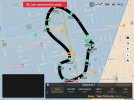Helpful hint for those taking advantage of the Mavic 3's new Waypoints firmware: DJI Fly constantly bugs you with exaggerated warnings we've grown used to ignore, but it doesn't warn you of a glaring danger with waypoints missions. When you record a waypoint mission, the waypoint heights are *relative* to your takeoff spot. If you record a waypoint mission having taken off from one spot, then move to another spot that's at 100 feet lower altitude, take off from there and reload your mission, the Fly app won't warn you that all your waypoints are now 100 feet lower, in absolute terms, than when you recorded the mission (because the relative altitudes stayed the same but they are relative to a different takeoff spot). So the waypoint that you marked back when you were at 800ft from sea level, the drone will now move towards that point while flying at 700ft from sea level.
Combine that with the fact that obstacle sensing doesn't detect fine objects like wires, and branches without foliage, and with the ability to set the drone to Continue on Signal Loss, and you have the recipe for disaster.
I wish DJI would at least warn about taking off at a lower absolute height than the one the waypoints were recorded.
Combine that with the fact that obstacle sensing doesn't detect fine objects like wires, and branches without foliage, and with the ability to set the drone to Continue on Signal Loss, and you have the recipe for disaster.
I wish DJI would at least warn about taking off at a lower absolute height than the one the waypoints were recorded.











